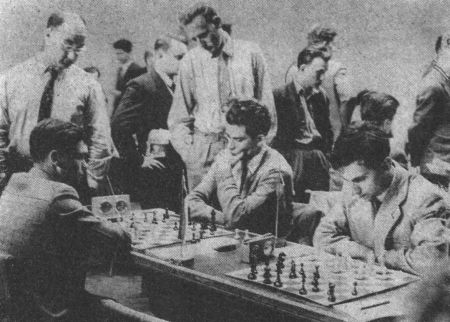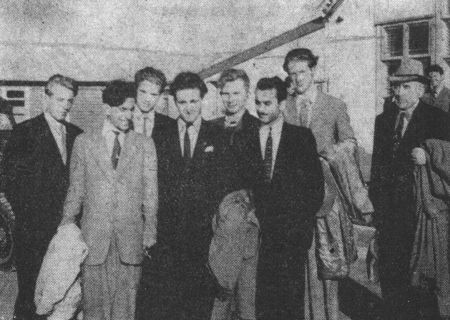Good work has been done. The modest beginnings of student tournaments in Liverpool 1952 and Brussels 1953 resulted in the already traditional World Student Championships which year after year gained great popularity amongst the students of the world.
 During the last years, very strong teams took part in the championships, including masters of world reputation. In Reykjavik for instance, two participants of the last tournament were the grandmaster Spassky from the Soviet Union and Filip from Czechoslovakia. On the first chess-board of the victorious Soviet team played the champion of the Soviet Union, a young student from Riga, grandmaster Tal. The team of the United States was led by a new young junior master of the world, Lombardy.
During the last years, very strong teams took part in the championships, including masters of world reputation. In Reykjavik for instance, two participants of the last tournament were the grandmaster Spassky from the Soviet Union and Filip from Czechoslovakia. On the first chess-board of the victorious Soviet team played the champion of the Soviet Union, a young student from Riga, grandmaster Tal. The team of the United States was led by a new young junior master of the world, Lombardy.
It can be said without hesitation that the standard of those world student championships reached almost that of the Olympic Chess Games.
But the World Student Championship has yet another important task to fulfil. It enables young chess players from all over the world to meet every year, not only at the chess table, but in a social way as well, exchange experiences, talk about their particular student problems and establish new friendships regardless of frontiers and language difficulties.
True to the spirit of those ideals the IUS has fully supported all world championships held up to date. The close co-operation with the International Chess Federation (FIDE) brought positive results. The World Student Championship had an important position within the framework of FIDE competition and its popularity increased year by year.
 At the FIDE congress in Moscow, in August 1956, it was decided to hold the IVth World Student Championship in Reykjavik. I remember, how at the beginning of October 1956 I started on the long journey to Iceland, together with Kurt Vogel, head of the IUS Sports Department. We discussed with our Icelandic chess and student friends all details of the next world championship. A preparatory organising committee was set up, consisting of Jaroslav Šajtar, a representative of FIDE, Kurt Vogel, representative of the IUS, Baldur Möller, representing the Iceland Government, Árni Snævarr, representative of the Mayor's Office, Pétur Sigurðsson, representative of Háskólaráðs, Jon Bödvarsson, representative of Stúdentaráðs, Bjarni Felixson, representative of Stúdentaráðs, Th. Ólafsson and F. Ólafsson, representatives of the Skáksambands Íslands.
At the FIDE congress in Moscow, in August 1956, it was decided to hold the IVth World Student Championship in Reykjavik. I remember, how at the beginning of October 1956 I started on the long journey to Iceland, together with Kurt Vogel, head of the IUS Sports Department. We discussed with our Icelandic chess and student friends all details of the next world championship. A preparatory organising committee was set up, consisting of Jaroslav Šajtar, a representative of FIDE, Kurt Vogel, representative of the IUS, Baldur Möller, representing the Iceland Government, Árni Snævarr, representative of the Mayor's Office, Pétur Sigurðsson, representative of Háskólaráðs, Jon Bödvarsson, representative of Stúdentaráðs, Bjarni Felixson, representative of Stúdentaráðs, Th. Ólafsson and F. Ólafsson, representatives of the Skáksambands Íslands.
It was decided that the tournament should take place between July 11th and 26th 1957. We were mainly concerned with the settling of the transport question for all teams registered for the competition. The Icelandic organisers and the PESD-IUS solved this difficult problem satisfactorily for all those concerned. On July 6th, representatives of 14 countries arrived in the capital of Iceland, ready to compete for the proud title of World Student Champion.
Fewer teams participated than in the last World Championship at Uppsala, but it must be taken into account that Iceland is a far-off country, and financial difficulties involved did not permit some countries to take part, in spite of the substantial help given by the Icelandic organisers who refunded ⅔ of the return travel expenses from Copenhagen to Reykjavik and contributed towards board and lodging fees. It is all the more necessary to mention the presence of such distant countries as Ecuador and the Mongolian People's Republic. On this occasion we might remember that the chess players of the Mongolian People's Republic belong to the youngest members of FIDE and at the last World Student Championship at Uppsala were represented by two observers only. A year later the Mongolian students could be found at the chess board, competing with their student friends from other countries. For interest's sake it should be pointed out, that they were the first Mongolians ever to enter Iceland.
With regard to quality it must be said that the Reykjavik competition had a better standard than all preceding ones. Last year's holders of the title, the Soviet students were obvious favourites from the very beginning and after a few rounds they clearly proved their superiority. A grim struggle ensued for the next places which was practically decided in the last round only.
 The Czechoslovaks who by their victory in Oslo in 1954 became the first official world champions, stayed for a long time closely behind the victorious Soviet team. Only in the last round they were surpassed by the Bulgarians, who beat Finland 4-0, whereas the Czechoslovak students gained only a close victory of 2½-1½. But both teams achieved great successes. The second victors of the last Championship in Uppsala, the Hungarian students, came fourth. Although their team was stronger than those of the last years, they were not as successful as usually and had to content themselves with an honourable, but all the same lower placing. Compared with last year the US players improved their position, whereas the Rumanian students scored slightly lower. The other teams kept their last years places. Perhaps more had been expected from the newcomers to the Championship, the Danish team. But their leading player, Great Master Larsen, was rather unlucky. The results of Iceland who were considered dangerous adversaries on their home ground can be evaluated in a similar way. Their leading player, international master F. Ólafsson, too, was not very successful.
The Czechoslovaks who by their victory in Oslo in 1954 became the first official world champions, stayed for a long time closely behind the victorious Soviet team. Only in the last round they were surpassed by the Bulgarians, who beat Finland 4-0, whereas the Czechoslovak students gained only a close victory of 2½-1½. But both teams achieved great successes. The second victors of the last Championship in Uppsala, the Hungarian students, came fourth. Although their team was stronger than those of the last years, they were not as successful as usually and had to content themselves with an honourable, but all the same lower placing. Compared with last year the US players improved their position, whereas the Rumanian students scored slightly lower. The other teams kept their last years places. Perhaps more had been expected from the newcomers to the Championship, the Danish team. But their leading player, Great Master Larsen, was rather unlucky. The results of Iceland who were considered dangerous adversaries on their home ground can be evaluated in a similar way. Their leading player, international master F. Ólafsson, too, was not very successful.
A great surprise was the efficient play by other newcomers, the Ecuador team, whose representatives gained several unexpected victories.
The team of the Mongolian People's Republic played their first international tournament and showed that they have good possibilities for developing successfully.
The tournament was efficiently organised and we were pleased to note the great interest of spectators and onlookers in the whole championship.
The Icelandic organisers made the students' stay in Reykjavik as pleasant as possible and organised many informal get-togethers. They provided them with possibilities to visit some of the Icelandic beauty spots and their world famous geysers.
When the Championship was over, all participants returned to their own countries full of admiration for the not very numerous, but industrious and friendly people of Iceland who love their country and endeavour to intensify and broaden friendly co-operation between nations regardless of the differences in political, economic an cultural structure.
It can be said that the IVth World Championship proved an all round success. It showed once again that the students of the world are very interested in chess and that the World Student Championship offers possibilities for better mutual understanding and the strengthening of co-operation between the students throughout the world.
No doubt, the 5th World Championship which will be held in July 1958 in the Bulgarian seaside town Varna will bring further good results in this respect.
/ Ing. Jaroslav Šajtar, International Chess Master and Vice-President of FIDE /